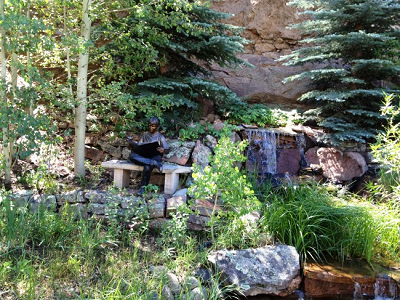Mrs. Walsh's Garden

Walk along the winding footpath that leads to a quiet pond. Rest peacefully on a bench or explore the garden during any season and become inspired by the abundant colors of nature.
Mrs. Walsh's Garden exists as a source of pleasure, education and inspiration by demonstrating the use of plants native to Estes Park and the surrounding Rocky Mountain Region.
This beautiful garden is located at the west end of Elkhorn Avenue across from Performance Park. The garden is open daily from dawn to dusk, is wheelchair accessible and admission is free.
False Solomon's Seal
Scientific Name: (Maianthemum stellatum)
Also called Star Lily, this delicate spring wildflower is commonly found in rich, moist woodland soils and ravines throughout a wide range of elevations in Colorado (plains to subalpine). Maianthemumis derived from Latin (Maia) and Greek (anthemum) meaning "May Flower".
Western Chokecherry
Scientific Name: Prunus virginiana var. demissa
This is a medium-sized, deciduous shrub or small tree with simple, ovate to elliptical leaves with finely-toothed margins. Clusters of fragrant, white to cream colored flowers are produced in May/June along drooping, densely packed, 2-5 inch flowering stalks. It typically grows in thickets in wooded and shrubby native habitats where adequate moisture is present in the soil. In August/September small chokecherries appear, initially being green but ripening to red, dark-red and almost black. Although the fruits have a very bitter taste and should not be eaten raw, they can be properly cooked to make jelly and syrup, or left for hungry birds.
Three-Leaf Sumac
Scientific Name: Rhus trilobata
This is a tough, drought tolerant, native shrub with small, chartreuse spring flowers that appear before the foliage, and red summer ripening fruit that is a source of food for birds. The "trifoliate" leaves turn shades of orange, yellow and red in the fall. The leaves have a very strong scent when crushed. The aroma is medicinal or bitter, disagreeable enough to some to have gained the plant the common name skunkbush. The flexible young stems have been used in basketry by Native Americans, accounting for one of the plant lesser-known common names: basketbush. It is drought resistant and will grow in a wide range of soil types.
Waxflower
Scientific Name: Jamesia americana
This is a medium-sized, deciduous shrub growing up to 4 feet high, blooming in June/July with flowers having 5 waxy, creamy white petals. The flowers are produced in erect, terminal panicles. The oval leaves with serrated margins are deeply veined. It typically grows on rocky slopes, on canyon cliffs or in crevices of large boulders. In September the deep green foliage changes to red/orange. The name Jamesia honors Edwin James, a 19th Century medical doctor and botanist who accompanied explorer Stephen Long's 1820 expedition to the southern Rocky Mountains of Colorado.
Western Virgin's Bower Vine
Scientific Name: Clematis ligusticifolia
This is a vigorous, showy, late summer-flowering vine growing on the split rail fence at Mrs. Walsh's Garden. The fragrant, small white flowers are followed by silky seed plumes that noticeably catch late afternoon sunlight when backlit. The deciduous leaves are pinnately compound with 5-7 leaflets. A member of the Buttercup Family (Ranunculaceae), it can typically be found growing on the ground, sprawling over shrubs, or even growing up to 20 ft. or more in trees. The plant was named by Thomas Nuttall, an English botanist and zoologist who lived and worked in America from 1808 until 1841.
Woods Rose
Scientific Name: Rosa woodsii
This is a prickly, native shrub with single, pink, fragrant, spring flowers in clusters of 2-4. The bright red fruit (hips), are persistent, providing much winter interest in the landscape. The fruits, a good source of energy and protein, are eaten by birds, squirrels, deer, coyotes, and bears. The pinnately compound leaves have 3-7 leaflets that turn shades of orange, yellow and red in the fall. Typically found growing on dry hillsides, its rhizomatous growth habit may be problematical in a garden situation. It is named for Joseph Woods, 1776-1864, an early English student of roses.